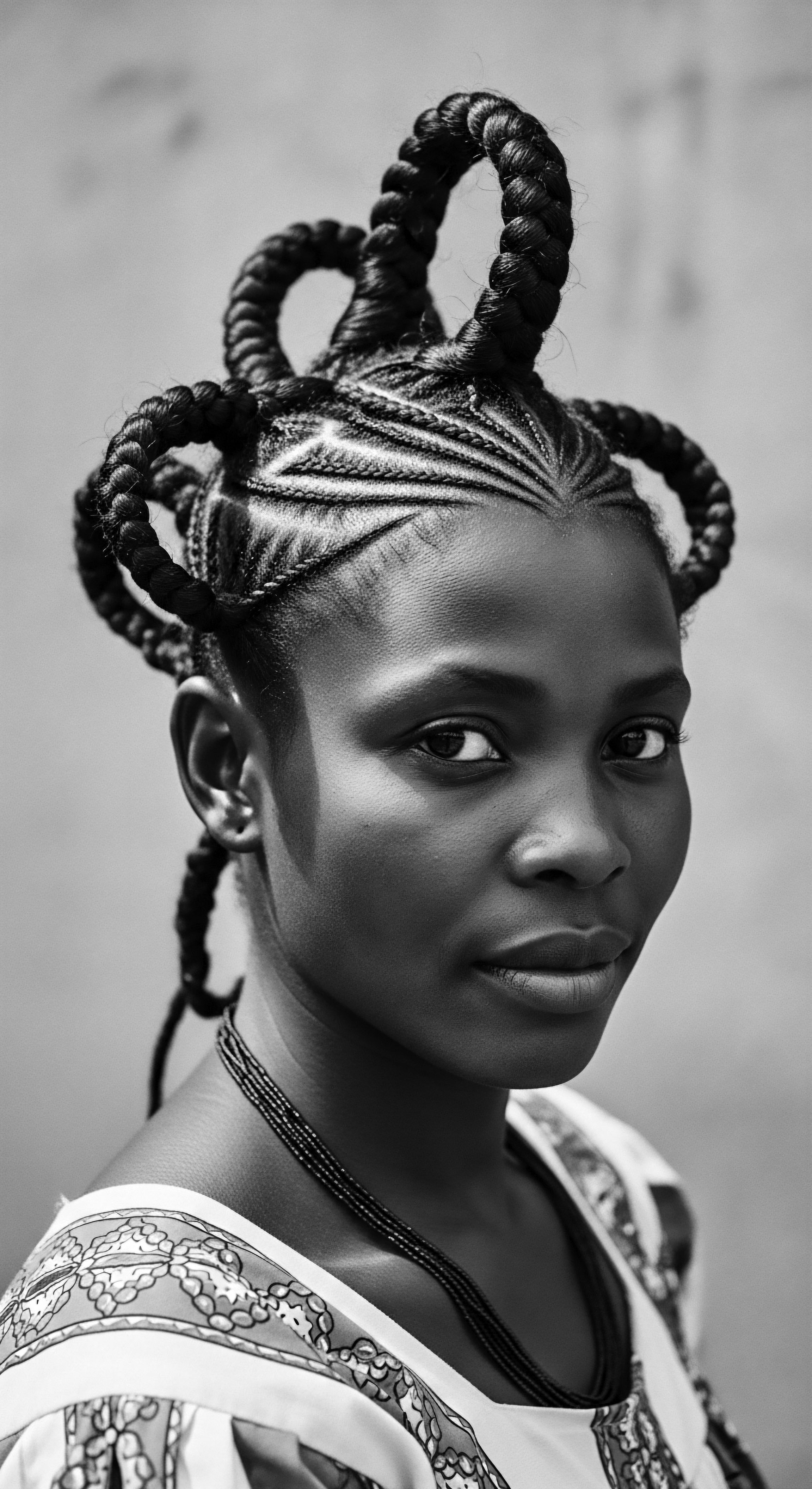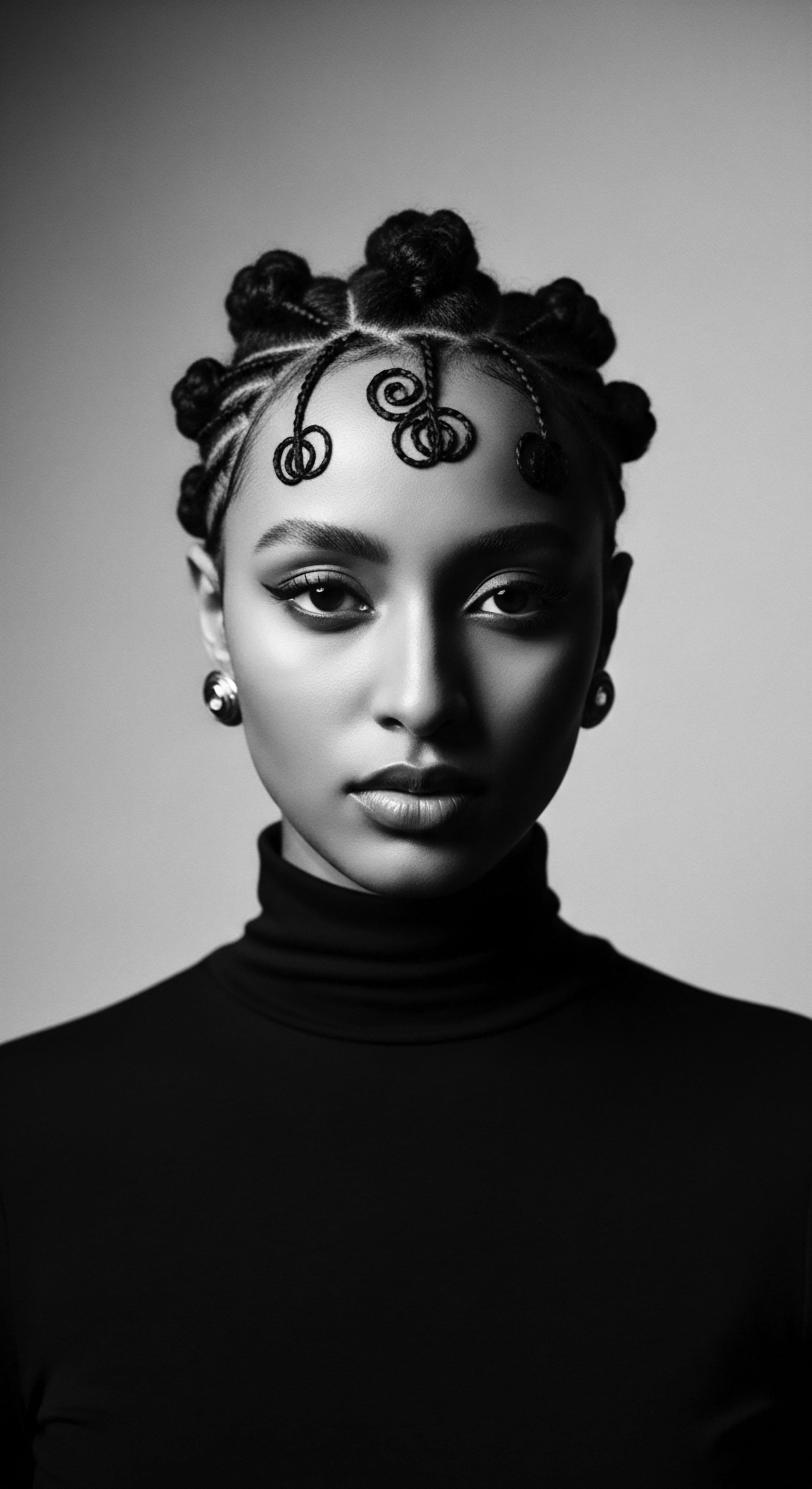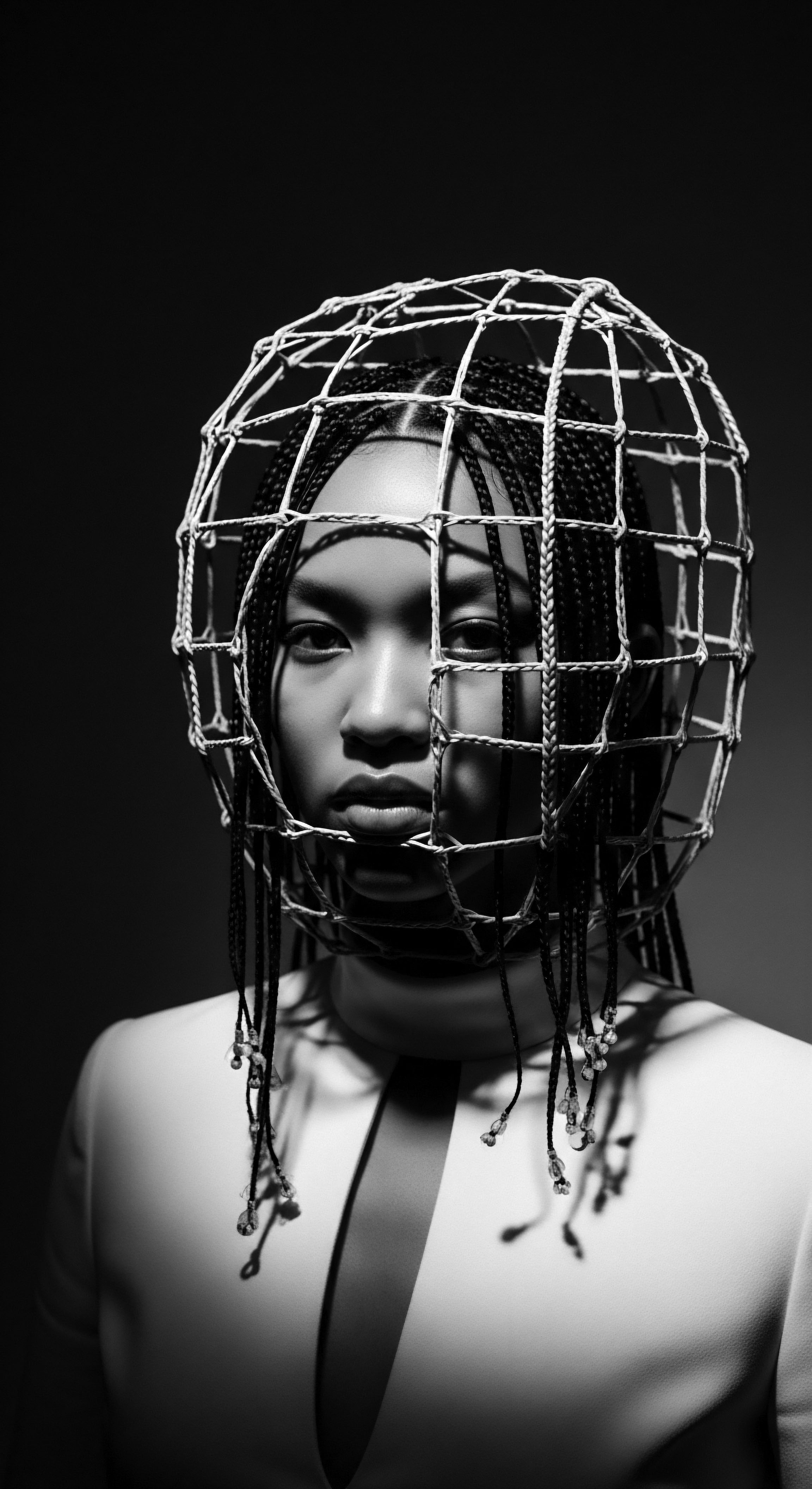
Roots
Consider, for a moment, the strand that spirals from your scalp, or perhaps the crown of coils that frames your countenance. This hair, in its very essence, is a living record, a testament to journeys both individual and ancestral. For those of us connected to Black and mixed-race heritage, our hair carries not just genetic code, but echoes of a profound past—a past where every twist, every braid, every carefully placed adornment spoke volumes. Within this living archive, the ancient African comb holds a distinguished place.
It was never merely a tool for detangling or styling; it was a communicator, a storyteller, a physical extension of identity, status, and collective memory. To comprehend the comb’s deep meaning is to peer into the soul of a strand, tracing its lineage back to the very source of human ingenuity and cultural expression.
From the earliest archaeological discoveries, extending back some seven thousand years, combs found in the lands of Kush and Kemet, now known as Sudan, South Sudan, and Egypt, reveal an extraordinary truth ❉ hair grooming was a serious endeavor, imbued with immense societal and spiritual weight. These early combs, often crafted from wood, bone, or ivory, were not only functional for managing diverse textured hair types but were also objects of remarkable artistry. Their designs often depicted animals, human figures, or symbols drawn from the natural world, each carrying a specific meaning within the prevailing belief systems of their era. For example, some Kemetian combs bore motifs of birds, bulls’ horns, or hippopotami, reflecting a deep reverence for nature and its spiritual forces.

Ancestral Hair Anatomy and Its Significance
Understanding the specific characteristics of textured hair is central to appreciating why ancient combs were designed as they were. African hair, broadly speaking, exhibits a range of coiling and curling patterns, from loose waves to tightly wound coils. This inherent structure, while beautiful and versatile, necessitates tools that can navigate its unique geometry without causing breakage or undue stress.
Ancient artisans, through generations of empirical wisdom, crafted combs with wider gaps between the teeth and often longer teeth, recognizing the need for gentler detangling and styling. This design foresight reflects an ancestral understanding of hair health that predates modern trichology.
Ancient African combs were more than mere tools; they were powerful symbols of identity, status, and deep cultural heritage, meticulously crafted to honor the unique characteristics of textured hair.
The relationship between hair and holistic well-being was keenly felt in these early societies. Hair was often regarded as a living antenna, a spiritual gateway connecting individuals to the divine and to their ancestors. As such, the care taken with hair, and the tools used in its grooming, were not incidental.
They were integral to one’s spiritual alignment, social standing, and connection to their lineage. The physical act of combing became a ritual, a moment of connection to self and to community, affirming one’s place within the intricate web of ancestral wisdom.

Early Materials and Symbolism
The choice of material for combs also held meaning. Early combs made of wood, bone, and ivory were not simply practical choices; they often carried associations with the natural world, with specific animals, or with the spiritual properties attributed to those materials.
- Wood ❉ Often sourced from specific trees, imbuing the comb with the tree’s perceived spiritual or medicinal properties.
- Bone ❉ Linked to ancestral lineage and the enduring spirit, a connection to the past.
- Ivory ❉ A precious material, denoting wealth, prestige, and often reserved for royalty or high-ranking individuals.
These materials, shaped with skill and intention, became canvases for symbolic expression, elevating the comb from a utilitarian object to a piece of wearable art, a marker of one’s place in the communal fabric.

Ritual
From the foundational understanding of textured hair, we journey into the vibrant ritual of its styling, where the ancient African comb found its most profound expression. These combs were not simply implements to manage hair; they were central to acts of self-expression, communal bonding, and the visual communication of social hierarchy. The very act of styling hair, particularly with the aid of these specialized combs, transcended mundane grooming to become a ceremonial engagement, a way of embodying one’s place within the collective heritage.
Consider the elaborate hairstyles documented in ancient African civilizations. These styles, often requiring significant time and skill, were meticulously maintained, and the combs were indispensable to their creation and preservation. Hair was, in many societies, a public canvas, relaying messages about an individual’s age, marital status, social group affiliation, and even spiritual beliefs. The comb, therefore, acted as a key to unlocking these visual narratives, a silent but powerful participant in the dialogue of identity.

How Did Comb Designs Reflect Social Standing?
The design and material of an ancient African comb often provided immediate visual cues about the owner’s status and wealth. Combs belonging to royalty or high-ranking individuals were typically more ornate, carved from rare or valuable materials, and bore intricate symbolic motifs. For example, archaeological findings show combs from predynastic Kemet used as status symbols, sometimes found in elite graves. While not conclusive proof that only elites used them, the presence of combs in such contexts, often alongside other high-status objects, points to their significant value as indicators of social standing.
The decorative elements themselves were not merely aesthetic choices; they were intentional symbols. Human figures, representations of animals, or abstract patterns could signify clan affiliation, lineage, or a person’s role within their community. A comb adorned with a particular animal might denote a family totem or a spiritual connection to that creature, thereby indicating the wearer’s specific heritage and a connection to a particular group or tribe.

Variations Across African Communities
The sheer diversity of African cultures meant that the symbolism embedded in comb designs varied widely from region to region, and from ethnic group to ethnic group.
- Ghana (Akan Tradition) ❉ The Dua’afe, a wooden comb, often symbolizes femininity and beauty, deeply connecting the comb to womanhood.
- Yoruba Tradition (Nigeria) ❉ Combs held social weight, used as gifts to signify the sealing or ending of friendships, or even as protective charms.
- Kemet (Ancient Egypt/Sudan) ❉ Early combs, some dating back 7,000 years, were highly decorative, with motifs like birds, bulls’ horns, and hippopotami, underscoring respect for the natural world and likely spiritual connections.
These regional distinctions highlight that the comb was a localized language, its meaning deeply rooted in the specific cultural heritage of its origin. This regional variation underscores the idea that combs were not just generic beauty tools, but cultural artifacts specifically designed for their communities, reinforcing identity and belonging.
Combs served as visual encyclopedias, their carvings and materials transmitting unspoken messages of social rank, tribal connection, and personal narrative across generations.
Beyond their symbolic power, combs were also practical necessities for maintaining the intricate styles that communicated these meanings. The wide teeth of traditional African combs were ideal for managing the unique coiled and curly textures of African hair, minimizing breakage and facilitating the creation of elaborate styles such as cornrows, braids, and up-dos. This functional aspect reinforced their ceremonial status; a tool that enabled such meaningful self-presentation became, in itself, a revered object. The deep intertwining of function and symbolism made these combs irreplaceable elements of communal life and expressions of cultural pride.

Relay
The narrative of the ancient African comb, a story of artistry and deep heritage, does not conclude in antiquity. Instead, it relays forward, a testament to enduring wisdom and the power of cultural memory, resonating through diasporic experiences and informing contemporary understanding of textured hair. The threads of ancestral practice persist, shaped by new contexts, yet retaining the core messages of identity and resilience that combs have always conveyed. This continuity reveals how fundamental objects, once imbued with meaning, carry their significance through time, becoming beacons of heritage across continents and generations.
The transatlantic forced migration presented an undeniable disruption to African hair traditions. Enslaved Africans often had their heads shaved, a deliberate and cruel tactic to strip them of their cultural identity and ancestral connection. Yet, despite this traumatic rupture, the knowledge of hair care, the ingenuity of styling, and the understanding of hair’s symbolic power were not erased.
Instead, these traditions adapted, often in secret, passed down through whispers and quiet rituals, ensuring the survival of a vital heritage. The very act of maintaining one’s hair, even without traditional tools, became a silent act of resistance, a reclamation of humanity and lineage.

How Did Ancient Comb Designs Influence Modern Hair Tools?
The design principles evident in ancient African combs—particularly their wider-spaced, longer teeth—laid the groundwork for modern tools suited to textured hair. This ancestral understanding of how to manage coily hair gently and effectively has re-emerged in contemporary hair care, validating the centuries-old wisdom of African communities. The contemporary wide-tooth comb, a staple for detangling and styling textured hair today, is a direct echo of these ancient designs, a functional legacy that speaks volumes about inherited knowledge. This echoes the fact that the users and makers of combs in Africa were aware that African type hair could be fragile and prone to breakage, leading to designs with more space between teeth.
A significant historical example of this relay from ancient wisdom to contemporary empowerment is the emergence of the “Afro pick” or “Afro comb” in the 20th century. During the Civil Rights Movement in the 1960s and 1970s, as Black Americans sought to reclaim their cultural identity and reject Eurocentric beauty standards, the Afro hairstyle gained immense popularity. The Afro comb, with its distinctive long teeth, became an indispensable tool for shaping and maintaining this natural style.
The enduring design of the African comb, with its wide, generous teeth, stands as a quiet testament to ancestral understanding of textured hair’s unique needs, a wisdom relayed through millennia.
Beyond its functional utility, the Afro comb, particularly those adorned with the iconic clenched “Black fist” motif, transcended its role as a grooming implement to become a powerful political emblem. Introduced in 1969 by Samuel H. Bundles, Jr. and Henry M.
Childrey, this comb symbolized Black pride, unity, and resistance against oppression. It was worn proudly in Afros, not merely as an adornment, but as a visible declaration of identity and a rejection of conformity, a clear statement of “no” to oppressive norms. This illustrates a powerful continuity ❉ the ancient comb as a marker of status and identity found a potent parallel in the modern era, signaling cultural pride and political defiance.
The story of the Afro comb, from ancient Kemet to the Civil Rights era, highlights how an object can carry profound cultural and political weight through millennia. It demonstrates that the practical innovations of ancestors continue to inform and inspire, providing a foundation for both healthy hair care and powerful expressions of identity in the present day. The very act of choosing to wear one’s hair in its natural state, and using tools designed for it, connects individuals to this expansive heritage, making each strand a bridge between past and present.
| Historical Period Ancient Kemet/Kush (7000-5500 BCE) |
| Design Characteristics Long, wide-spaced teeth; carved from wood, bone, ivory; decorated with animal/human motifs. |
| Societal Significance Status symbol, spiritual connection, communal identity marker, tool for sacred hair rituals. |
| Historical Period West African Traditions (Pre-Colonial) |
| Design Characteristics Varied regional designs; often wooden, with intricate carvings reflecting local cosmology and social roles. |
| Societal Significance Femininity, beauty, tribal affiliation, ceremonial use in rites of passage, markers of friendship. |
| Historical Period American Civil Rights Era (1960s-1970s) |
| Design Characteristics Long teeth; often made of plastic; notable "Black fist" handle. |
| Societal Significance Symbol of Black pride, cultural rebellion, political statement, tool for maintaining the Afro hairstyle. |
| Historical Period The comb's persistent adaptation underscores its enduring role as a vessel for identity and heritage across time and changing social landscapes. |

Reflection
As we trace the remarkable journey of the African comb, from its earliest ancestral forms to its resonant echoes in contemporary textured hair culture, a truth becomes abundantly clear ❉ this object is a living testament to an enduring heritage. It is not simply a piece of history confined to museum displays; it is a vibrant pulse within the collective memory of Black and mixed-race communities, speaking volumes about resilience, identity, and the profound wisdom passed down through generations. The comb, in its myriad forms, has always been an intimate companion to textured hair, shaping not only physical styles but also narratives of selfhood and belonging.
The very act of tending to textured hair with a comb—whether a modern wide-tooth version or a lovingly preserved heirloom—becomes a conscious participation in a lineage stretching back millennia. It is a moment where biology meets heritage, where the unique structure of the hair strand connects to the hands that shaped it, the cultures that celebrated it, and the tools that honored its distinct nature. This shared ritual of care, anchored by the comb, transcends mere aesthetics; it reaches into the deepest wells of ancestral practices, affirming a legacy of beauty, strength, and ingenuity.
Roothea’s ethos, “Soul of a Strand,” speaks to this very connection. It invites us to consider every hair on our head as a repository of stories, a fiber of our collective history. The ancient African comb, in its detailed carvings and purposeful design, serves as a powerful reminder that our hair has always been a crown, a site of profound personal and communal meaning.
It stands as a silent witness to eras of creativity, challenge, and triumph, consistently reminding us that even in the face of adversity, the spirit of our heritage, expressed through our hair and its tools, remains unyielding and beautifully unbound. The legacy of the comb encourages us to continue this exploration, allowing ancestral wisdom to guide our appreciation and care for the unique tapestry that is textured hair.

References
- Ashton, S. A. (2013). Origins of the Afro Comb ❉ 6,000 Years of Culture, Politics and Identity. Cambridge ❉ The Fitzwilliam Museum.
- Byrd, A. & Tharps, L. (2001). Hair Story ❉ Untangling the Roots of Black Hair in America. St. Martin’s Press.
- Dabiri, E. (2020). Twisted ❉ The Tangled History of Black Hair Culture. HarperCollins.
- Ibaze, O. L. (2022). Crowning Glory ❉ A History of African Hair Tradition (Africa is Not a Country Series).
- Okoro, K. (2018). Hair It Is ❉ Examining the Experiences of Black Women with Natural Hair. (Published as a research paper).
- Shaw, T. (1978). Nigeria ❉ Its Archaeology and Early History. Thames and Hudson.
- Tulloch, C. (2013). The Afro Comb ❉ A Global History of Hair Culture. (From exhibition materials/research).
- Wilcox, C. (2013). The History of the Afro Comb. (Independent research/publication, often cited in online resources).
